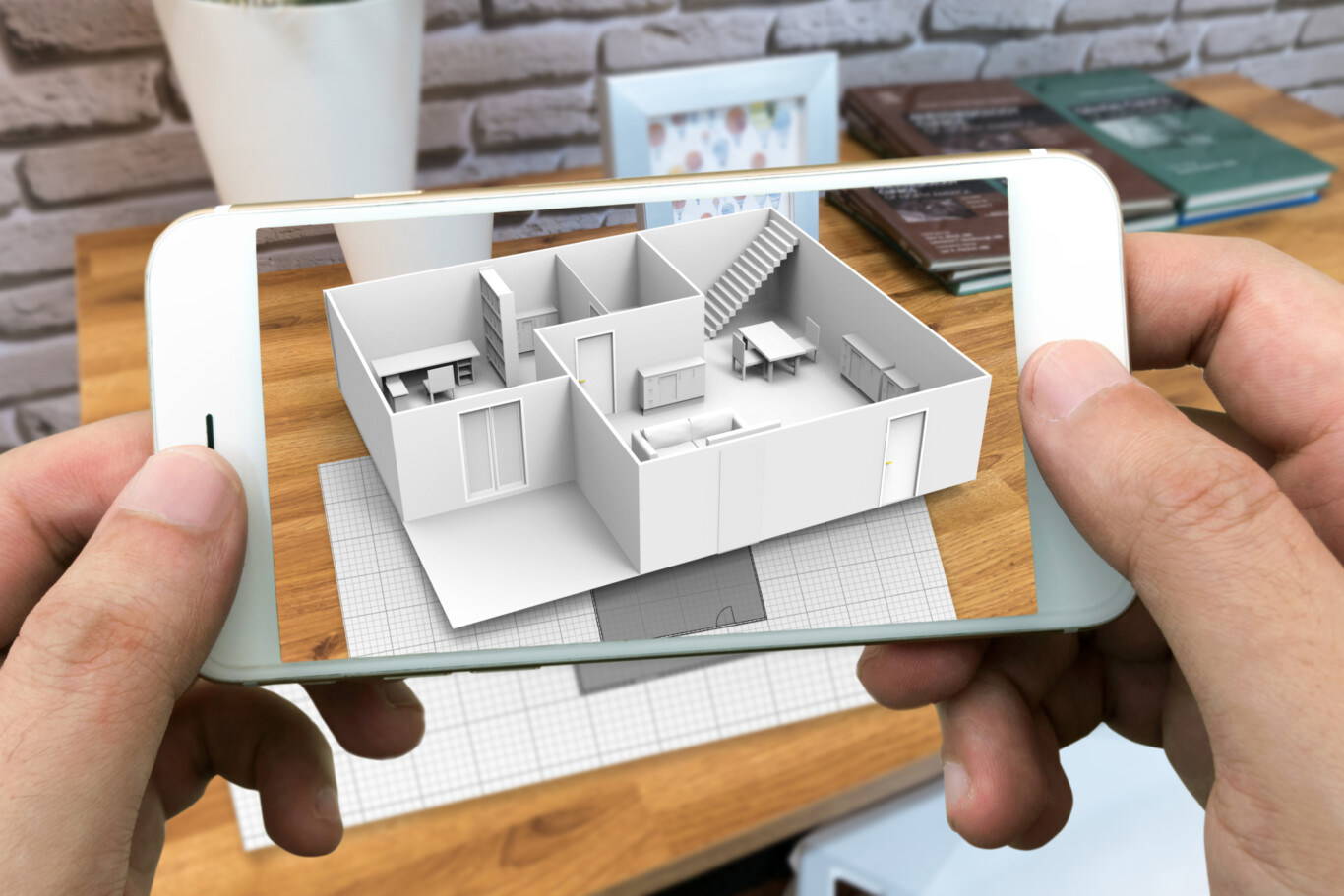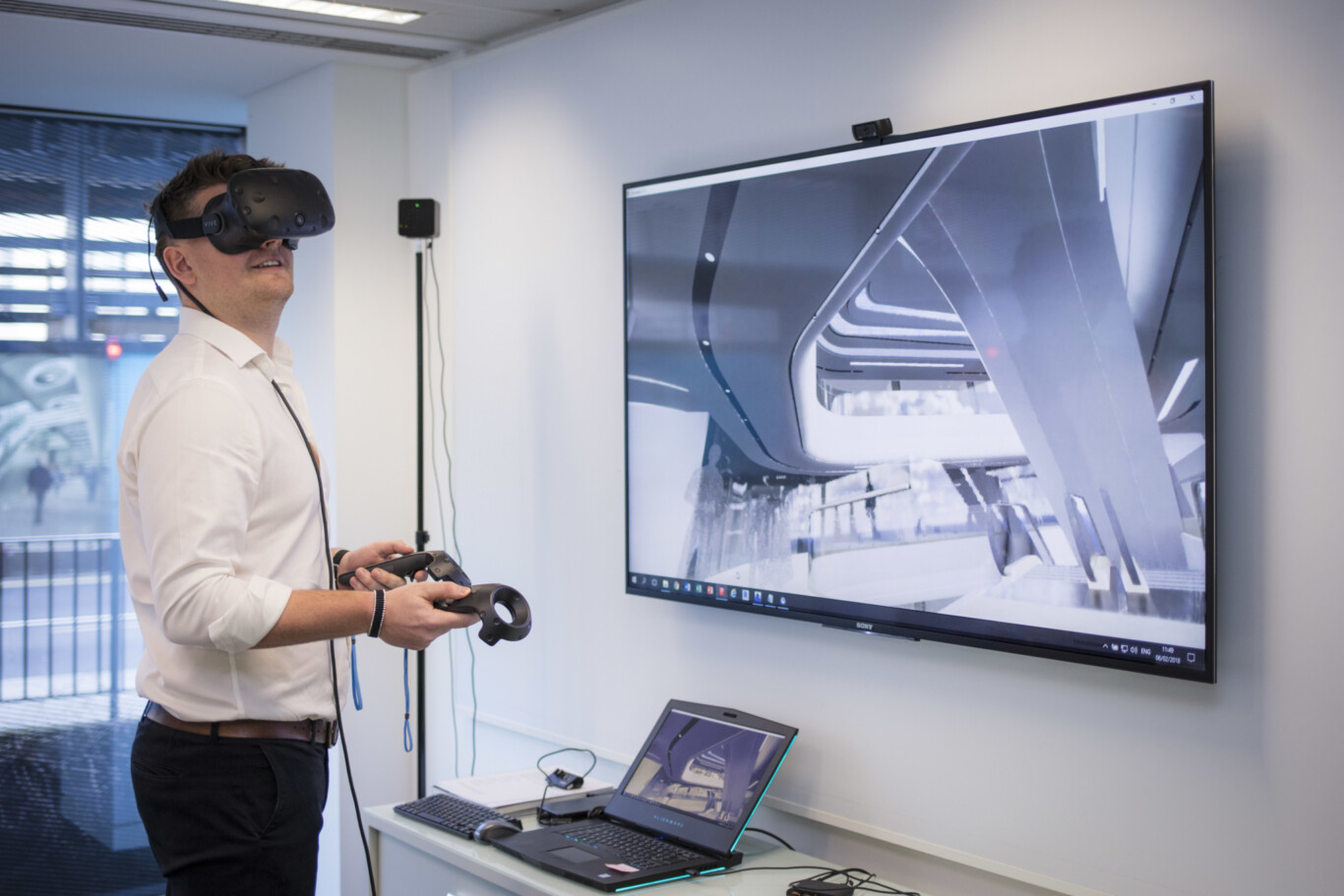What are the benefits to architects and clients of using Virtual Reality technology in the design process?
Digital technology has become a crucial design and showcasing tool for companies across the property sector, and Virtual Reality (VR) is a key part of that trend. Businesses which embrace the opportunities afforded by various forms of Immersive Media are finding that it brings numerous advantages, helping them to pull ahead of their competitors. In this piece, written in 2018, Chapman Taylor Director Andy Hudson explains how some of the key types of VR work and the advantages they bring for designers, clients and others.
Digital technology has transformed the way in which architectural practices conceive, design and deliver places and spaces. Building Information Modelling (BIM), using computer applications such as Revit, combines data with a three-dimensional representation of a given project, consolidating all relevant information in one place, with any subsequent adjustments being incorporated across the entire model to illustrate the wider impact of changes made. BIM is a key method of massively reducing time, cost and waste in design and construction, and Chapman Taylor has embraced it with enthusiasm.
The advantages brought about by BIM are now being enhanced by the increasing use of Virtual Reality (VR) technology. With VR equipment becoming increasingly available and affordable, new possibilities are being opened up for designers, for clients and for other stakeholders. In this piece, we will look at some of the types of VR technology which are coming to prominence in the property industry, particularly in design practices such as Chapman Taylor’s, and at some of the key benefits arising from the adoption of VR in the design and execution of built environments.
The Immersive Media Spectrum
The term Immersive Media covers a number of different 3D visualisation technologies, including Virtual Reality (VR), Augmented Reality (AR) and Mixed Reality (MR). These technologies exist on a ‘spectrum’ of increasing complexity, technological maturity and corresponding levels of industry adoption.
There is some degree of overlap with the various technologies, but a broad clarification of the terminology may be helpful at this point:
Virtual Reality (VR) allows users to experience a design scheme in three dimensions from a viewpoint within the scheme as if they were physically standing within the virtual environment, rather than from an external viewpoint looking at a screen or drawing.
Augmented Reality (AR) and Mixed Reality (MR) overlay digital information onto the real world. There is much discussion over the definition of the terms AR and MR, and both represent forms of Augmented Reality. We prefer to define AR as a basic overlaying of digital data and MR as a more complex interaction between digital information and the real world environment. In very simple terms, AR will show a digital representation of a chair in a room, MR will understand that there is a table and correctly display the chair behind the table.
The Immersive Media Spectrum has five basic components. The most basic forms are technologically less advanced, have corresponding levels of technological maturity and are the most widely adopted and easiest to implement:
360 Degree Stills and Videos
Applications such as Enscape, 3DS Max and Autodesk Revit can be used to create single-point 360 degree panoramic views of a design which allow the user to look around and experience the design as if standing in the space. This technique can also be used in animation, where the viewer is able to control what they look at while moving on a fixed path through the space. A number of single-point 360 degree panoramas can be linked together using a program such as RoundMe, creating a controlled tour of the project.
Mobile VR
The availability of smartphones with built-in gyroscopes means that they are a popular method for displaying VR, either as a standalone device or combined with Mobile Head-Mounted Displays (HMDs). HMDs are a much more immersive method of experiencing projects – the real world is blocked out, allowing users to experience fixed-point panoramas and videos. Headsets can be range in price from as little as £5 for Google Cardboard to £100 for Samsung Gear. The headset allows the wearer to experience a 3D simulation where they can look and tilt in various directions from a prescribed viewpoint, but doesn’t allow for interaction with the environment, such as moving, bending down or looking around corners, for example.
Augmented Reality
Augmented Reality (AR) is growing in profile. The AR environment incorporates digital objects within the real physical space people inhabit, in a manner which will be familiar to anyone who has ever played Pokemon Go. This can be done using purpose-created viewing devices/headsets or via an app on a smartphone or tablet – meaning that designers and clients can use AR to easily picture a proposed building scheme or other features in their intended environment before ground has been broken there. Portability, as with Mobile VR, is a key advantage of the technology.
Desktop VR
Desktop VR represents a new order of design and presentation tool – the experience is completely immersive and allows for much greater interaction than, for example, Mobile VR. Using a VR-ready laptop or a desktop computer with a suitable graphics card, together with a headset, controller and base station (e.g. Oculus Rift or HTC Vive) and software such as Enscape or Unity (for experiencing Revit models in VR), a design model can be experienced in extraordinary detail and realism. The user feels as if they are inside the built environment and able to interact with the space, moving around it freely. The technology allows for a level of understanding of, and engagement with, the design which was simply impossible a few years ago. The ability for a multi-use experience, with more than one person within the virtual environment at the same time, allows for a more personal and inclusive medium for presenting designs to clients.
Mixed Reality
Mixed Reality (MR), the newest emerging form of Augmented Reality, is currently most associated with the Microsoft HoloLens headset. MR is a means of visualising an object or project model within the real physical environment of the wearer, blending the physical and digital world. Being less immersive than VR, the wearer of the headset is not isolated from their surrounding environment or from colleagues within the room, the MR experience is often more easily accepted by those less experienced with the technology, however when used as a VR experience it is less immersive and consequently less powerful than desktop VR. The technology can be used in any place so that, for example, a building design might be viewed as a hologram on top of a desk at work. Rapidly emerging technologies allow for virtual group meetings to interrogate the virtual model, which can be viewed in real time in separate geographic locations – a very exciting opportunity for design team collaboration.
Who benefits?
The benefits of using immersive media technologies vary with the level of investment made in it – 360 degree images and videos are easily accessible and can be very useful, but don’t offer the sheer level of immersion and interaction available with Desktop VR. If we use the latter as an example, though, we can very clearly see two classes of beneficiaries – those involved in designing/building and the client/end-users.
Benefits as a design tool
Seeing versus predicting
The most obvious advantage of using VR is that the designer can see the end result of their work before it has been built. This allows them to inspect their model in previously impossible detail at an early stage, helping them grasp its complexities much more comprehensively.
Better space visualisation
It is rare for humans to be able to replicate the spatial characteristics of a given environment in our mind’s eyes – making it inevitable that corrections and adjustments were traditionally required when translating a designer’s vision to reality. VR changes the game in this respect. Being able to virtually inhabit the space gives the designer a very precise idea of the spatial qualities of their project, including the relationships between spaces and the way in which, for example, light and sound operate within them.
Massive savings
The use of immersive technology saves time – the ability to build the project virtually means that design glitches and unforeseen problems are seen and caught earlier, long before the project reaches building stage, thus preventing needless delays. This also leads to substantial financial savings in reduced labour, capital and material costs, as well as saving on the environmental waste caused by having to correct problems, spend longer on site, etc.
Allows for greater and earlier collaboration
Another reason for the savings outlined above is that the various contractors/stakeholders involved can ‘meet’ inside the VR model. This allows a range of interests and disciplines to collaborate and help inform the final design from an early stage, in detail, bringing their own perspectives to the process. The design’s minutiae can be communicated in a way which was not previously possible, making it easier to avoid translation problems across specialisms (e.g. between engineers and interior designers).
Benefits for clients and end-users
In-depth visualisation
Clients, buyers, tenants, and other stakeholders can see the designer’s vision in a much more immediate way with VR. It is hard, naturally, for other people to clearly picture a designer’s vision from drawings or on-screen models – even from 3D models. Experiencing the design from within, in the level of detail that the cutting edge of VR technology allows, can, by contrast, provoke a visceral engagement with the design. It is not unknown for clients to feel emotional when first seeing their scheme in this way. It also allows them to engage with the designer in greater detail, and to guide the design process more closely towards their desired result.
Accelerates the process
For reasons already mentioned, massive time and cost savings are available as a result of the availability of much-improved visualisation at an early stage. This potentially offers the client the opportunity for increased profits or the ability to sell/rent more competitively. The detailed design efficiencies achieved can also lead to savings, such as in operating costs and in avoiding later correction work. The benefits of a speedier delivery also spread to tenants, buyers, consumers and others.
Transforms the sale of off-plan property
The availability of immersive virtual walk-throughs for building projects means that developers who sell off-plan can showcase their products in an unprecedented way, making it easier to instil confidence in potential customers. Potential buyers now have the ability to virtually envisage how buildings will come to look and feel in reality, giving them more information when choosing whether to go ahead. Multiple design, colour and furniture options can all be experienced interactively within the virtual world, leading to more decisive choices, saving time and providing greater certainty for all.
Chapman Taylor has invested in state-of-the-art Desktop Virtual Reality (VR) technology to add to its existing VR capabilities. Our VR technology gives our designers and clients the opportunity to experience the projects they are working on in a completely immersive way, even before construction has begun. Clients who have used our technology to explore our BIM models virtually have spoken about how it made the design easily accessible to them, allowing them to perceive their projects in a new light. We are already using Mobile VR technology, and we are also exploring Augmented/Mixed Reality technology to assess its benefits for our design teams and clients.

